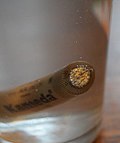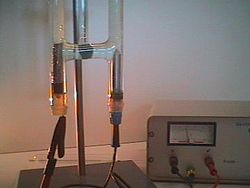Electrolysis of water
Electrolysis of water is the decomposition of water into oxygen and hydrogen gas. This technique can be used to produce breathable oxygen or hydrogen gas as a fuel source, referred to as hydrogen fuel. However, that method is more expensive than the industrial way to produce hydrogen fuel from natural gas.
This is what is referred to as a non-spontaneous reaction which requires impetus.
At the cathode, reduction (in this case, the gain of electrons) occurs. At the anode, oxidation (in this case, the loss of electrons) occurs. The half-equations for the electrolysis of pure water or without the presence of an acid or a base is shown below.
- the reduction at cathode: 2 H2O(l) + 2e− → H2(g) + 2 OH−(aq)
- the oxidation at anode: 2 H2O(l) → O2(g) + 4 H+(aq) + 4e−
Note that some textbooks or sources may show the half-equations with H+ and OH− as the reactants for the half-equations, but that is inaccurate due to the low autoionization of water.
Normally, the reaction is balanced with either an acid or a base as shown in the equations below.
- the oxidation at anode: 2 H2O(l) → O2(g) + 4 H+(aq) + 4e−
That two reactions are half reactions. They are balanced with an acid. Commonly hydrochloric acid or sulfuric acid is used. However, the half reactions can also be balanced with a base, for example with sodium hydroxide.
- the reduction at cathode: 2 H2O(l) + 2e− → H2(g) + 2 OH−(aq)
- the oxidation at anode: 4 OH−(aq) → O2(g) + 2 H2O(l) + 4 e−
Combining one pair of half reactions leads to an overall reaction, which is then the decomposition of water into oxygen and hydrogen.
- complete reaction: 2 H2O(l) → 2 H2(g) + O2(g)
Electrolysis Of Water Media
An AA battery in a glass of tap water with salt showing hydrogen produced at the negative terminal
Device invented by Johann Wilhelm Ritter to develop the electrolysis of water
Diagram showing the overall chemical equation.
Hofmann voltameter connected to a direct current power supply
Theoretical thermal water splitting efficiencies. 60% efficient at 1000°C *Steam reforming of hydrocarbons to hydrogen is 70-85% efficient
Illustrating inputs and outputs of simple electrolysis of water, for production of hydrogen.








